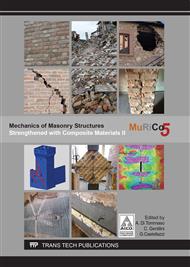p.374
p.382
p.390
p.398
p.406
p.414
p.423
p.431
p.440
Consolidation Methods of Romanian Historical Building with Composite Materials
Abstract:
Timisoara is a growing city in the western part of Romania, in a seismic area, with a lot of masonry buildings with historical and cultural value, with interesting structural elements such as vaults, arches, slabs, walls, that were affected by earthquakes, subsidence of foundations, negative human actions or lack of interventions. Masonry historical structures in Banat seismic area present particular failure mechanisms, so there is a need for new, modern, fast, easy-to-apply and reversible consolidation methods. With this type of methods is possible to assure the local and global resistance, ductility, stability and rigidity for historical buildings. This article shows the consolidation methods that were applied on the buildings Sf. Gheorghe 3 and 4, in the historical centre of Timisoara, on masonry structures with historical value. The solutions that were applied are using new, innovative fibre-reinforced composite materials, in order to repair the existing damages and prevent further ones. The consolidation solutions with these new composite materials reduce the buildings vulnerability and present the advantage of being fast and easy to be executed.
Info:
Periodical:
Pages:
406-413
Citation:
Online since:
July 2017
Authors:
Price:
Сopyright:
© 2017 Trans Tech Publications Ltd. All Rights Reserved
Share:
Citation:


